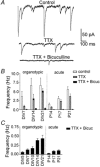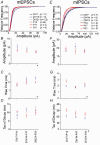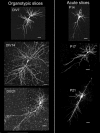Development of rat CA1 neurones in acute versus organotypic slices: role of experience in synaptic morphology and activity
- PMID: 12879864
- PMCID: PMC2343027
- DOI: 10.1113/jphysiol.2003.039099
Development of rat CA1 neurones in acute versus organotypic slices: role of experience in synaptic morphology and activity
Abstract
Despite their wide use, the physiological relevance of organotypic slices remains controversial. Such cultures are prepared at 5 days postnatal. Although some local circuitry remains intact, they develop subsequently in isolation from the animal and hence without plasticity due to experience. Development of synaptic connectivity and morphology might be expected to proceed differently under these conditions than in a behaving animal. To address these questions, patch-clamp techniques and confocal microscopy were used in the CA1 region of the rat hippocampus to compare acute slices from the third postnatal week with various stages of organotypic slices. Acute slices prepared at postnatal days (P) 14, 17 and 21 were found to be developmentally equivalent to organotypic slices cultured for 1, 2 and 3 weeks, respectively, in terms of development of synaptic transmission and dendritic morphology. The frequency of inhibitory and excitatory miniature synaptic currents increased in parallel. Development of dendritic length and primary branching as well as spine density and proportions of different spine types were also similar in both preparations,at these corresponding stages. The most notable difference between organotypic and acute slices was a four- to five-fold increase in the absolute frequency of glutamatergic (but not GABAergic)miniature postsynaptic currents in organotypic slices. This was probably related to an increase in complexity of higher order dendritic branching in organotypic slices, as measured by fractal analysis, resulting in an increased total synapse number. Both increased excitatory miniature synaptic current frequency and dendritic complexity were already established during the first week in culture. The level of complexity then stayed constant in both preparations over subsequent stages, with synaptic frequency increasing in parallel. Thus, although connectivity was greater in organotypic slices, once this was established, development continued in both preparations at are markably similar rate. We conclude that, for the parameters studied, changes seem to be preprogrammed by 5 days and their subsequent development is largely independent of environment.
Figures






Similar articles
-
Protracted postnatal development of inhibitory synaptic transmission in rat hippocampal area CA1 neurons.J Neurophysiol. 2000 Nov;84(5):2465-76. doi: 10.1152/jn.2000.84.5.2465. J Neurophysiol. 2000. PMID: 11067989
-
Pathway specificity of dendritic spine morphology in identified synapses onto rat hippocampal CA1 neurons in organotypic slices.Hippocampus. 2006;16(12):1111-24. doi: 10.1002/hipo.20236. Hippocampus. 2006. PMID: 17068782
-
The hyperexcitability of dentate granule neurons in organotypic hippocampal slice cultures is due to reorganization of synaptic inputs in vitro.Physiol Rep. 2016 Oct;4(19):e12889. doi: 10.14814/phy2.12889. Physiol Rep. 2016. PMID: 27707779 Free PMC article.
-
Miniature synaptic transmission and BDNF modulate dendritic spine growth and form in rat CA1 neurones.J Physiol. 2003 Dec 1;553(Pt 2):497-509. doi: 10.1113/jphysiol.2003.052639. Epub 2003 Sep 18. J Physiol. 2003. PMID: 14500767 Free PMC article.
-
Spontaneous recurrent network activity in organotypic rat hippocampal slices.Eur J Neurosci. 2005 Jul;22(1):107-18. doi: 10.1111/j.1460-9568.2005.04198.x. Eur J Neurosci. 2005. PMID: 16029200
Cited by
-
Input-specific regulation of hippocampal circuit maturation by non-muscle myosin IIB.J Neurochem. 2015 Aug;134(3):429-44. doi: 10.1111/jnc.13146. Epub 2015 May 29. J Neurochem. 2015. PMID: 25931194 Free PMC article.
-
Evolution of Network Synchronization during Early Epileptogenesis Parallels Synaptic Circuit Alterations.J Neurosci. 2015 Jul 8;35(27):9920-34. doi: 10.1523/JNEUROSCI.4007-14.2015. J Neurosci. 2015. PMID: 26156993 Free PMC article.
-
Fine-tuning of neuronal architecture requires two profilin isoforms.Proc Natl Acad Sci U S A. 2010 Sep 7;107(36):15780-5. doi: 10.1073/pnas.1004406107. Epub 2010 Aug 23. Proc Natl Acad Sci U S A. 2010. PMID: 20798032 Free PMC article.
-
The BDNF effects on dendritic spines of mature hippocampal neurons depend on neuronal activity.Front Synaptic Neurosci. 2014 Mar 20;6:5. doi: 10.3389/fnsyn.2014.00005. eCollection 2014. Front Synaptic Neurosci. 2014. PMID: 24688467 Free PMC article.
-
Slice culture modeling of central nervous system (CNS) viral infection.Methods Mol Biol. 2013;1078:97-117. doi: 10.1007/978-1-62703-640-5_9. Methods Mol Biol. 2013. PMID: 23975824 Free PMC article.
References
-
- Cannon RC, Wheal HV, Turner DA. Dendrites of classes of hippocampal neurons differ in structural complexity and branching patterns. J Comp Neurol. 1999;413:619–633. - PubMed
-
- Caserta F, Stanley HE, Eldred WD, Daccord G, Hausman RE, Nittmann J. Physical mechanisms underlying neurite outgrowth: a quantitative analysis of neuronal shape. Phys Rev Lett. 1990;64:95–98. - PubMed
-
- Collin C, Miyaguchi K, Segal M. Dendritic spine density and LTP induction in cultured hippocampal slices. J Neurophysiol. 1997;77:1614–1623. - PubMed
-
- Coltman BW, Earley EM, Shahar A, Dudek FE, Ide CF. Factors influencing mossy fiber collateral sprouting in organotypic slice cultures of neonatal mouse hippocampus. J Comp Neurol. 1995;362:209–222. - PubMed
Publication types
MeSH terms
Substances
LinkOut - more resources
Full Text Sources
Miscellaneous

